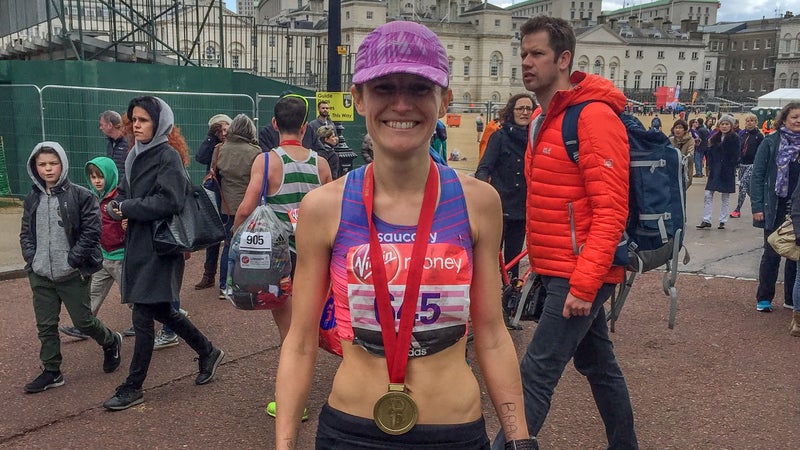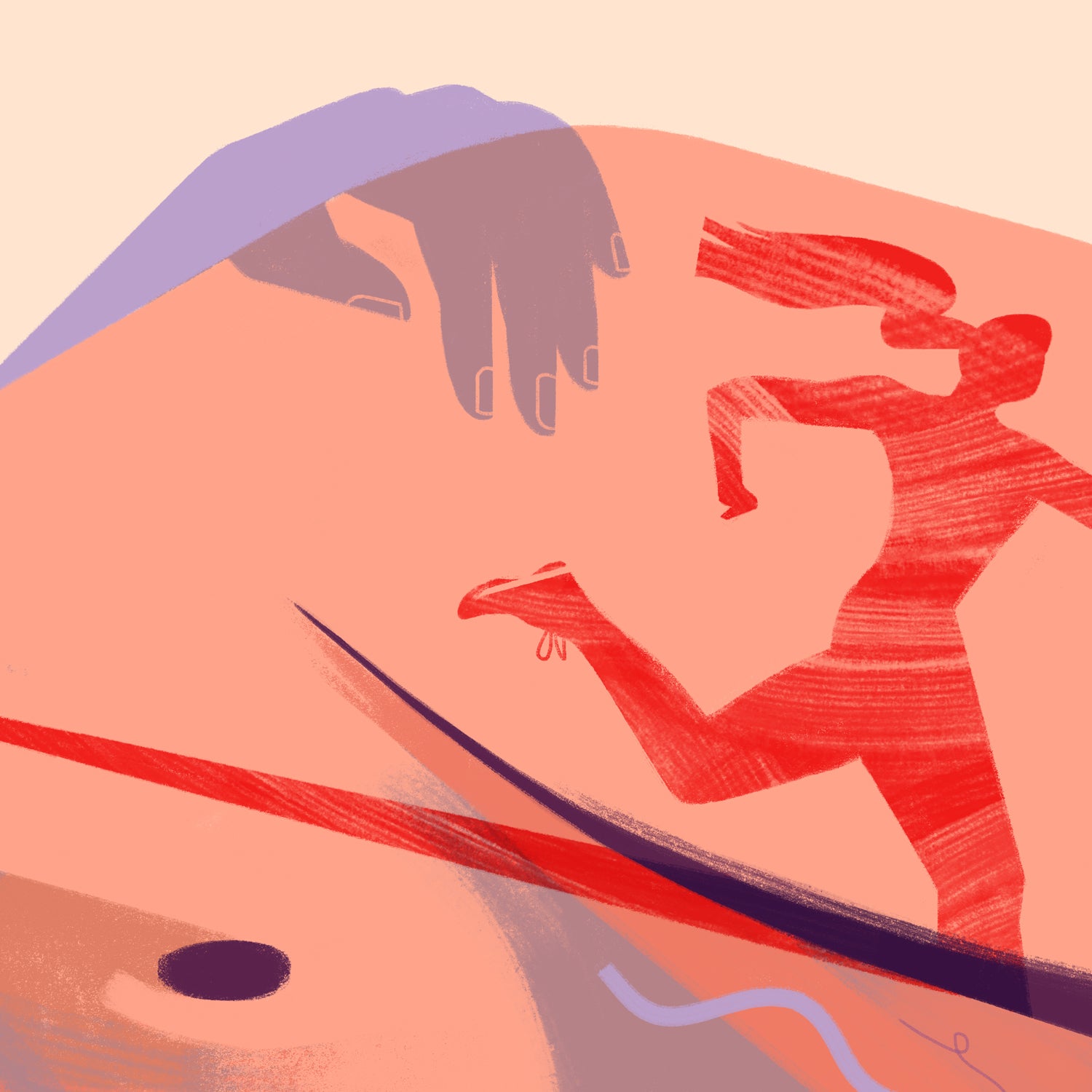Standing on the starting line of the 2016 World Half Marathon Championships in Cardiff, Wales, Tina Muir put her hands on her hips. For 13 years, she’d chased her dream of representing Great Britain and Northern Ireland on the world stage. Now, she had arrived. Along the course, the home crowd cheered, buoying Muir in the cold, windy conditions. When she turned the final corner and spotted the finish line, Muir smiled. She finished 49th.
Muir had reached an apex in her career. She felt strong and confident and was in the best shape of her life, running between 90 and 100 miles per week and following a dedicated strength-training program. A few weeks after crossing the finish line in Cardiff, Muir ran a 2:37 personal record at the London Marathon. Then, in December, she lowered her PR again, notching a 2:36 at the California International Marathon, finishing fifth overall.
But in March 2017, Muir, who now lives in Lexington, Kentucky, made a : She said she was quitting running. While burnout played a role in her decision, there was a larger health concern at play. The 28-year-old hadn’t had a period in nine years, and she wanted to start a family. “I love to run, but having a family is something I’ve always wanted,” Muir says. “I knew the logistics. If you’re not having your cycle, you can’t get pregnant.”
Muir first got her period at age 15. After two to three years of regular cycles, it started to fluctuate depending on the intensity of her running. She lost it for a few months while running roughly 30 miles a week and regained it when she took time off from the sport. Then, when Muir started at Ferris State University, where she was an 11-time All-American in cross-country and track and field, her workouts ramped up to 50 miles per week. “I was pushing myself more than I had in the past and became more invested in performance,” she says. Muir was on birth control at the time and still having her period, but eventually it disappeared.
At first, Muir was relieved, but deep down she knew something was wrong. “Your period is such a normal, human thing, and it wasn’t happening for me,” she says. “It’s horrible feeling like your body is broken.”

She began to see doctors, specialists, and nutritionists to find an answer for her absence of menstruation, a condition called amenorrhea. They discussed Muir’s diet and analyzed her blood and urine. Everything appeared normal, including her appetite. Doctors even induced a period with a dose of hormones to stimulate menstruation and prove there was nothing wrong internally.
Doctors and specialists kept telling Muir the same thing: If she wanted to regain her period, she needed to stop running. “I was doing everything right—eating the right foods and resting. I wasn’t suffering from overtraining or stress fractures, but something was still wrong,” says Muir. “I was frustrated and confused. ‘Stop running’ sounds so simple, but for someone whose career was this sport, someone whose entire day revolved around their training, it really wasn’t plausible.”
“It’s horrible feeling like your body is broken.”
Many in the running community believe that losing your period is what happens when you run a lot and you’re an elite or Olympic-caliber runner. For others, it’s a badge of honor, a sign that you’re tough and working hard. But there’s also a stigma attached to missing your cycle. Some women are embarrassed, while others fear being labeled with an eating disorder. Muir, for example, worried that sharing her experience with amenorrhea might affect her career and her chances of being chosen for a national team if Great Britain didn’t think she was healthy. For these reasons, women often don’t speak up and might not tell their doctor that their cycle has stopped. Yet an estimated have experienced some form of amenorrhea.
Amenorrhea can have a long-term impact on a woman’s health. Not only can it affect fertility, but that it can also influence cardiovascular health, resulting in higher cholesterol levels and causing the cells lining the heart and blood vessels not to dilate in response to blood flow increase, which can contribute to coronary artery disease, hypertension, and diabetes.
Doctors are usually most worried about bone health. Hormones—like estrogen—released during menstruation are needed to build strong bones, especially during adolescence and young adulthood. Women achieve between age 20 and 30. Those who miss their period during this critical time may not ever achieve their maximum bone mass, putting them at increased risk for osteoporosis and fractures. Research shows that female adolescent runners have compared to nonrunners, and that amenorrheic athletes have weaker .
“[Amenorrhea] is the canary in the coal mine,” says Dr. Liz Joy, president of the American College of Sports Medicine and president of the Female Athlete Triad Coalition. “Skipping periods can be a sign you’re not meeting your energy needs with your current dietary intake.” If you don’t eat enough to support both your exercise and daily activities, your body goes into conservation mode, shuttling energy to systems that are essential for survival as a way to protect you.
Normally, the hypothalamus, a region of the brain, releases hormones to stimulate the development of eggs and ovulation each month. When the body doesn’t have enough energy, this cascade of hormones and signals is suppressed, says Dr. Kathryn Ackerman, director of the Female Athlete Program at Boston Children’s Hospital. Women who start their period at a later age or have a low body-mass index are at greater risk for amenorrhea, as are runners, due to the high-energy demand of the sport and the perceived competitive advantage of being lean.
Amenorrhea is also a key element in what’s known as the , a constellation of three interrelated conditions—energy availability, menstrual function, and bone-mineral density—which exist on a spectrum from healthy to disordered. While they frequently coexist, the presence of any one element is enough to diagnose the triad.
Except in cases of pregnancy or certain (such as polycystic ovarian syndrome or hyperthyroidism), a lack of menstruation is likely due to insufficient energy available in the body, which is often linked to not eating enough. According to Mary Jane De Souza, a professor of kinesiology and physiology at Penn State University, there are several ways you can end up with less energy than your body needs, causing menstrual disturbances. Both clinical eating disorders and disordered eating patterns, such as consciously restricting food groups or adhering to strict food rules, can result in a shortage of energy. Some women unintentionally undereat. They may eat three meals a day plus snacks but not take in enough calories to keep up with their activity level. Still others may experience a calorie deficit because they’re trying to lose weight.
In , De Souza found that cutting 470 to 810 calories a day compared to baseline needs over as little as three menstrual cycles can alter your period. Some changes were overt, while others were subtle and didn’t elicit physical symptoms, making it harder to detect a problem. There’s no specific threshold under which you’ll lose your period; it varies by individual and can be a delicate balance. “It doesn’t have to be pathologic, just a mismatch that’s enough to tip the balance,” says Ackerman.
A lack of menstruation is likely due to insufficient energy available in the body, which is often linked to not eating enough.
Muir prides herself on eating well and not restricting food. During training, she ate between 3,000 and 3,500 calories a day. With the help of a nutritional consultant, she tweaked her diet in hopes of coaxing her period to return, including more healthy fats and quality protein in her diet and reducing her sugar intake. She also regularly tracked her blood biomarkers to make sure her vitamins, minerals, and inflammation markers were in check. But nothing seemed to help Muir climb out of the energy debt created by her high exercise volume.

Joy says that addressing the balance between energy consumption and expenditure is key to tackling amenorrhea. “Sit down with a sports nutritionist and do the math,” she says. “If you don’t succeed in getting sufficient energy relative to exercise expenditure, switch it up.” Include more active rest in your schedule, like an easy walk or hike. Add a yoga or Pilates session. Foam roll to loosen your muscles and work on your range of motion. “Then it’s not always about burning calories, and your energy debt is a little less,” says Joy.
Runners should be aware that birth control can make it difficult to assess if the body isn’t getting enough fuel to have a period. “Hormonal contraception, especially oral contraceptive pills, can mask the loss of menstruation as a sign of low energy availability” and can further affect bone health, says Joy. The same is true of other forms of contraception, like progesterone-containing IUDs, birth control implants, and shots. (Birth control patches or a vaginal ring, on the other hand, release hormones that are absorbed through the skin instead of metabolized by the body.)
Muir hasn’t run in two months and is focused on nourishing her body. She’s working with her doctors and an endocrinologist to regain her period. (She stopped taking birth control pills years ago.) Muir is eating, resting, and doing a minimal amount of activity, like walking or taking a trampoline class for fun. She’s gained roughly 15 pounds so far. “I feel like things are moving in the right direction,” she says. Most of all, Muir feels like she can relax, have fun, and not worry about the pressures of professional running. “I used to be afraid of walking across the grass because I didn’t want to tweak anything,” she says. “I don’t have to wrap myself in cotton roll anymore.”
She’s blown away by the number of women who’ve reached out to her since her announcement to say they’ve also experienced amenorrhea. Recently, a host of professional and amateur athletes have started speaking out about losing their periods. Elyse Kopecky made her 15-year battle with amenorrhea a centerpiece in , the cookbook she co-authored with her college teammate Shalane Flanagan, the four-time U.S. Olympic distance runner. The , a community for active women, launched earlier this year and frequently features stories about the prevalence of amenorrhea, eating disorders, and the female athlete triad. They strive to create a community of support for women recovering from these conditions.
It has encouraged Muir to share her story. “Saying you have amenorrhea should be just like saying, ‘I have an ear infection.’ It’s nothing to be ashamed about it,” she says. “I’m getting help for it, and it will be better soon.”


